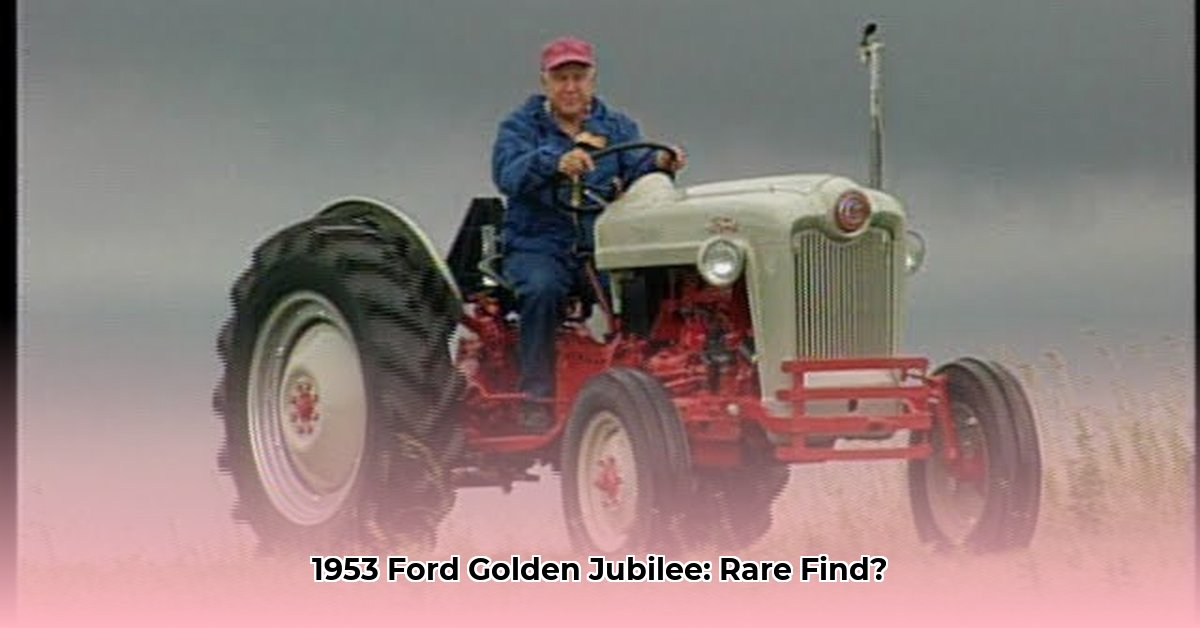
A Piece of Agricultural History You Can Own
The 1953 Ford NAA Golden Jubilee tractor isn't just any old farm machine; it's a captivating piece of history, a head-turner for enthusiasts and a prized possession for collectors worldwide. This special edition, commemorating Ford's 50th anniversary, boasts a unique style. Its sleek hood and distinctive Golden Jubilee grille badge set it apart. But what truly elevates this tractor to collector status? Let's explore the factors that make it such a desirable classic. Owning one isn't just about owning a tractor; it's about owning a piece of living history, a symbol of bygone agricultural practices, and a testament to mid-20th-century engineering. For more information on Ford tractor values, check out this helpful resource: Ford Tractor Values.
Under the Hood: The NAA's Mechanical Heart
This classic tractor features a 134 cubic inch, four-cylinder gasoline engine. Its 20.2 horsepower was quite impressive for the 1950s. While this power might seem modest by today's standards, remember the context: this workhorse was designed to tackle the farming challenges of its time. Paired with a four-speed manual transmission—typical for the era—the NAA's relatively straightforward design is a boon for restoration enthusiasts. The simplicity makes it achievable, although finding parts will become a quest that we will explore later in this guide.
What Drives Collectors Crazy About This Tractor?
For serious collectors, originality is paramount. A perfectly preserved, entirely original 1953 Ford Golden Jubilee tractor commands top dollar. Every detail matters! Collectors will scrutinize aspects such as original Firestone tires (including size and tread!), the original paint job, and even period-correct accessories (like a Dearborn bumper). These details collectively contribute to the tractor's overall value and authenticity. Comprehensive paperwork and documentation further enhance its desirability, offering irrefutable proof of its heritage and pedigree. This explains why some tractors fetch substantial prices while others don't; it's the attention to original detail.
The Challenges (and Triumphs!) of Restoration
Restoring a 1953 Ford Golden Jubilee is a journey, a labor of love, and a test of patience. Rust is a frequent adversary; it's a common enemy of aging metal. Engine problems, whether stemming from age or neglect, are also frequently encountered. And then there's the parts hunt! Original parts are scarce, necessitating the use of aftermarket alternatives. While these serve a functional purpose, original parts always command a higher premium.
Step-by-Step Restoration: A Practical Guide
- Thorough Inspection: Begin with a meticulous examination, documenting the tractor's condition—including rust, mechanical issues, and missing parts—with copious photographs.
- Careful Disassembly: Dismantle the tractor methodically, maintaining organization and labeling each component for straightforward reassembly. Clean each piece thoroughly as you proceed.
- Targeted Restoration: Address rust, repair or replace damaged components, and repaint using historically accurate colors. This is where the tractor's character is truly revitalized.
- Meticulous Reassembly: Reassemble the tractor painstakingly, adhering precisely to proper procedures and torque specifications, using a service manual as an invaluable guide.
- Rigorous Testing: After reassembly, test all systems comprehensively to ensure proper functionality before operation.
Tracking Down Those Elusive Parts
Securing parts for a Golden Jubilee can be daunting. Online forums dedicated to classic tractors, such as Yesterday's Tractors, are excellent resources. Local salvage yards also present opportunities for discovery. Joining a Ford tractor owners' club is another smart strategy; you'll connect with experienced individuals who can offer invaluable advice and insights. Always carefully weigh the cost-benefit analysis of choosing between original versus reproduction parts, keeping in mind the impact on value.
Market Value: How Much Will Yours Fetch?
The value of a 1953 Ford NAA Golden Jubilee tractor fluctuates substantially. Condition, originality, and location all significantly affect the final price. Scrutinizing auction results and online listings provides a useful indication of current market trends. However, remember to factor in restoration costs. Such a project is a significant undertaking, demanding both financial resources and a considerable time commitment. It's not a get-rich-quick scheme; it’s a passion project.
Weighing the Risks: A Risk Assessment Matrix
| Risk Factor | Likelihood | Impact | Mitigation |
|---|---|---|---|
| Engine Failure | Medium | High | Regular maintenance, thorough pre-purchase inspection |
| Parts Shortages | High | Medium | Network with enthusiasts and suppliers, explore alternatives |
| Overpaying | Medium | High | Do your homework, get independent appraisals |
| Rust & Corrosion | Medium | Medium | Careful assessment, factor restoration costs into budget |
The Bottom Line: A Rewarding Endeavor
The 1953 Ford NAA Golden Jubilee tractor transcends its function as a machine; it’s a piece of American agricultural history. While restoration demands commitment and resources, the rewards of owning a beautiful, historically significant tractor are immense. It's a labor of love and a testament to passion for classic machinery. The journey might be challenging, but the destination—owning a piece of living history—is undeniably worthwhile.